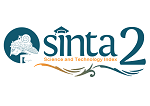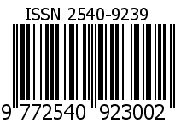Exploring adolescents’ digital information-seeking patterns and religious behavior
Abstract
Generation Z adolescents' religious information-seeking behavior has undergone significant transformations in understanding and studying the patterns of searching, processing, and using religious information. Research gaps exist in local cultural variations on transforming Generazion Z adolescents' religious information-seeking behavior in the digital era, which also occurs in information access patterns, social media platform preferences, and responses to religious content. This study focused on information access using the Ellis Model to analyze the behavior of information search stages: browsing, chaining, filtering, monitoring, and understanding adolescents' religious preferences. This study used a qualitative approach with a case study method involving Rohis activists from six high schools in three cities, Medan, Yogyakarta, and Makassar, as research samples. Data were collected through observation and FGD. Study results showed that Generation Z accessed religious information digitally through social media due to its accessibility and interactivity. However, they still referred to local and popular religious figures to clarify and validate religious information. Social media played an important role in shaping religious views despite the challenges of spreading misinformation and disinformation. Their information-seeking behavior reflected a combination of digital exploration and conventional references; adolescents actively utilized, created, and shared religious information. The Ellis Model's relevance in understanding information-seeking behavior in the digital era and cultural variations contributes to information behavior study by highlighting the dynamics of technology use in meeting the younger generation's spiritual needs. Practical implications include recommendations for improving digital literacy through technology-based education and partnerships with religious authorities to provide credible and moderate content.
Keywords
Full Text:
PDFReferences
Akyıldız, S. T., & Ahmed, K. H. (2021). An overview of qualitative research and focus group discussion. International Journal of Academic Research in Education, 7(1), 1–15. https://doi.org/10.17985/ijare.866762
Albadri. (2023). The convergence of traditional media to the digital communicative environment-the reality and gap. Information Sciences Letters, 12(4), 1827–1839. https://doi.org/10.18576/isl/120408
Aliani, S. O., Alam, M. S., Rofiq, A., & Srinio, F. (2023). The role of Islamic religious counselors in providing religious understanding of ta’lim councils in minority areas. Dirasah International Journal of Islamic Studies, 1(2), 89–101. https://doi.org/10.59373/drs.v1i2.19
APJII. (2024). Survei penetrasi internet Indonesia 2024. https://survei.apjii.or.id/survei/group/9
Arma, M. A., & Nelisa, M. (2013). Perilaku pencarian informasi pemustaka. Jurnal Ilmu Informasi Perpustakaan Dan Kearsipan, 1(2), 16–23. https://doi.org/10.24036/1087-0934
Azizah, N., Nurdianzah, E., Wijaya, M. M., Azami, T., & Rohman, A. (2023). Religious moderation in the industrial era 4.0: Deradicalization through the development of intellectual traditions at Fadhlul Fadhlan Islamic Boarding School Semarang. Jurnal Pendidikan Agama Islam, 20(2), 233–246. https://doi.org/10.14421/jpai.v20i2.7771
Bazen, A., Barg, F. K., & Takeshita, J. (2021). Research techniques made simple: An introduction to qualitative research. Journal of Investigative Dermatology, 141(2), 241–247. https://doi.org/10.1016/j.jid.2020.11.029
Bhandari, D., Ozaki, A., Kobashi, Y., Higuchi, A., Shakya, P., & Tanimoto, T. (2020). Cancer information seeking and scanning behavior among Nepalese migrants in Japan and its association with preventive behavior. PLOS ONE, 15(6), 1–17. https://doi.org/10.1371/journal.pone.0235275
Case, D. O. (2012). Looking for information: A survey of research on information seeking, needs and behavior. Emerald Group Pub.
Cho, H., Pham, M. T. N., Leonard, K. N., & Urban, A. C. (2022). A systematic literature review on image information needs and behaviors. Journal of Documentation, 78(2), 207–227. https://doi.org/10.1108/JD-10-2020-0172
Dalimunthe, M., & Purwaningtyas, F. (2020). Akses informasi literasi keislaman rohis di Indonesia: Analisis konstruksi keberagamaan. Perspektif, 9(2), 378–387. https://doi.org/10.31289/perspektif.v9i2.3550
Davidson, E., Edwards, R., Jamieson, L., & Weller, S. (2019). Big data, qualitative style: A breadth-and-depth method for working with large amounts of secondary qualitative data. Quality & Quantity, 53(1), 363–376. https://doi.org/10.1007/s11135-018-0757-y
Diepeveen, S., & Pinet, M. (2022). User perspectives on digital literacy as a response to misinformation. Development Policy Review, 40(S2), 1–16. https://doi.org/10.1111/dpr.12671
Fatayan, A., Syarif, M. S., & Ghani, A. R. A. (2018). The role of University of Muhammadiyah Prof. Dr. Hamka (UHAMKA) in developing holistic education. Asian Journal of Social Sciences & Humanities, 7(4), 22–32. http://www.ajssh.leena-luna.co.jp/AJSSHPDFs/Vol.7(4)/AJSSH2018(7.4-03).pdf
Febriani, S. R., & Ritonga, A. W. (2022). The perception of millennial generation on religious moderation through social media in the digital era. Millah: Journal of Religious Studies, 21(2), 313–334. https://doi.org/10.20885/millah.vol21.iss2.art1
Freeman, J. L., Caldwell, P. H. Y., & Scott, K. M. (2023). How adolescents trust health information on social media: A systematic review. Academic Pediatrics, 23(4), 703–719. https://doi.org/10.1016/j.acap.2022.12.011
Hartati, M., & Wulan, A. P. (2016). Analisis nilai moral yang terkandung dalam novel Ayat-Ayat Cinta karya Habiburrahman El Shizary. Jurnal Pendidikan Bahasa, 5(1), 138–151. https://journal.ikippgriptk.ac.id/index.php/bahasa/article/download/306/303
Hidayat, T. R., Mulyadi, R., & Purwaningtyas, F. (2023). Analisis pola perilaku penelusuran informasi di kalangan mahasiswa UINSU. El-Mujtama: Jurnal Pengabdian Masyarakat, 3(3), 937–944. https://doi.org/10.47467/elmujtama.v3i3.3082
Hosen, N. (2019). Challenging traditional Islamic authority: The impact of social media in Indonesia. Proceedings of International Conference on Da’wa and Communication, 1(1), 84–100. https://doi.org/10.15642/icondac.v1i1.280
Hura, G. S., & Singhal, M. (2001). Data and computer communications. In Data and Computer Communications: Networking and Internetworking (tenth edit). CRC Press. https://doi.org/10.1201/9781420041316
Ishak, M. S., Sarkowi, A., Mustaffa, M. F., & Mustapha, R. (2022). Acceptance of Youtube for Islamic information acquisition: A multi-group analysis of students’academic discipline. International Journal of Advanced Computer Science and Applications, 13(7), 927–937. https://doi.org/10.14569/IJACSA.2022.01307108
Jannah, A. (2023). Peran pendidikan agama Islam dalam membina karakter religius siswa sekolah dasar. Pendas: Jurnal Ilmiah Pendidikan Dasar, 5(2), 1–14. https://doi.org/10.23969/jp.v8i2.10090
Jati, W. (2023). Hijrah phenomenon among indonesian muslim middle class: Current causes & challenges. Al-Qalam, 29(2), 363. https://doi.org/10.31969/alq.v29i2.1296
Jauhiainen, J. S., Özçürümez, S., & Tursun, Ö. (2022). Internet and social media uses, digital divides, and digitally mediated transnationalism in forced migration: Syrians in Turkey. Global Networks, 22(2), 197–210. https://doi.org/10.1111/glob.12339
Lee, M., Yun, J. J., Pyka, A., Won, D., Kodama, F., Schiuma, G., Park, H., Jeon, J., Park, K., Jung, K., Yan, M.-R., Lee, S., & Zhao, X. (2018). How to respond to the fourth industrial revolution, or the second information technology revolution? Dynamic new combinations between technology, market, and society through open innovation. Journal of Open Innovation: Technology, Market, and Complexity, 4(3), 21. https://doi.org/10.3390/joitmc4030021
Maknun, M. L., Hidayat, R. A., Ridlo, S., mustolehudin, Huda, N., Noviani, N. L., Samidi, Masfiah, U., & Ruchani, B. (2022). Literatur keagamaan rohis dan wacana intoleransi. Litbangdiklat Press. https://doi.org/10.31219/osf.io/xhkyj
Marsh, V. L., & Hoff, M. J. (2019). New literacies in participatory cultures: The assumption of trust. E-Learning and Digital Media, 16(5), 393–412. https://doi.org/10.1177/2042753019863489
Miles, M. B., Huberman, A. M., & Saldana, J. (2018). Qualitative data analysis: A methods sourcebook. SAGE Publications.
Mowbray, J., Hall, H., Raeside, R., & Robertson, P. J. (2018). Job search information behaviours: An ego-net study of networking amongst young job-seekers. Journal of Librarianship and Information Science, 50(3), 239–253. https://doi.org/10.1177/0961000618769965
Mrah, I. (2022). Digital media literacy in the age of mis/disinformation: The case of Moroccan University students. Digital Education Review, 41, 176–194. https://doi.org/10.1344/der.2022.41.176-194
Noh, Y. (2015). Imagining library 4.0: Creating a model for future libraries. The Journal of Academic Librarianship, 41(6), 786–797. https://doi.org/10.1016/j.acalib.2015.08.020
Nurhayati, M. A., Wirayudha, A. P., Fahrezi, A., Pasama, D. R., & Noor, A. M. (2023). Islam dan tantangan dalam era digital: Mengembangkan koneksi spiritual dalam dunia maya. AL-AUFA: Jurnal Pendidikan Dan Kajian Keislaman, 5(1), 1–27. https://doi.org/10.32665/alaufa.v5i1.1618
Pelletier, M. J., Krallman, A., Adams, F. G., & Hancock, T. (2020). One size doesn’t fit all: A uses and gratifications analysis of social media platforms. Journal of Research in Interactive Marketing, 14(2), 269–284. https://doi.org/10.1108/JRIM-10-2019-0159
PPIM UIN Jakarta. (2017). “Api dalam sekam” keberagamaan muslim gen-z, survei nasional tentang keberagamaan di sekolah dan universitas di Indonesia. https://ppim.uinjkt.ac.id/wp-content/uploads/2020/11/Survey-Nasional-Keberagamaan-GenZ.pdf
PPIM UIN Jakarta. (2021). Hasil penelitian PPIM Jakarta “Beragama ala anak muda: Ritual no, konservatif yes.” https://ppim.uinjkt.ac.id/2021/12/09/launching-hasil-penelitian-ppim-uin-jakarta-beragama-ala-anak-muda-ritual-no-konservatif-yes/
Prasojo, L. D., & Yuliana, L. (2021). How is social media used by Indonesian school principals for instructional leadership? Jurnal Cakrawala Pendidikan, 40(1), 70–80. https://doi.org/10.21831/cp.v40i1.32925
Prijana, Abdussalam, R., Pancasona, R. G., & Sulaiman, K. A. (2023). Ellis’s model of student information-seeking behavior on Google Scholar. Jurnal Kajian Informasi & Perpustakaan, 11(2), 305–320. https://doi.org/10.24198/jkip.v11i2.47204
Purwaningtyas, F. (2018). Literasi informasi dan literasi media. Iqra’: Jurnal Perpustakaan Dan Informasi, 12(2), 1–9. http://repository.uinsu.ac.id/3909/
Rachinger, M., Rauter, R., Müller, C., Vorraber, W., & Schirgi, E. (2019). Digitalization and its influence on business model innovation. Journal of Manufacturing Technology Management, 30(8), 1143–1160. https://doi.org/10.1108/JMTM-01-2018-0020
Rahmawati, Bahrudin, F. A., & Legiani, W. H. (2023). Peran sekolah dalam upaya menangkal radikalisme. Journal of Civic Education, 6(2), 145–151. https://doi.org/10.24036/jce.v6i2.1020
Rahmawati, W., Willcox, J. C., van der Pligt, P., & Worsley, A. (2021). Nutrition information-seeking behaviour of Indonesian pregnant women. Midwifery, 100, 103040. https://doi.org/10.1016/j.midw.2021.103040
Reed, T. V. (2018). Digitized lives (2nd ed.). Routledge. https://doi.org/10.4324/9781315143415
Retpitasari, E., & Oktavia, N. A. (2020). Preference of social media usage in teenagers religion. Tribakti: Jurnal Pemikiran Keislaman, 31(1), 17–34. https://doi.org/10.33367/tribakti.v31i1.985
Santos, A. P., & Caldas, F. C. (2016). Information behavior and evaluation of library services. Informação & Sociedade, 26(1), 91–101. https://www.proquest.com/docview/1801981805?ac-&sourcetype=Scholarly Journals
Saura, J. R., Ribeiro-Soriano, D., & Palacios-Marqués, D. (2022). Assessing behavioral data science privacy issues in government artificial intelligence deployment. Government Information Quarterly, 39(4), 101679. https://doi.org/10.1016/j.giq.2022.101679
Soong, A., Au, S. T., Kyaw, B. M., Theng, Y. L., & Tudor Car, L. (2020). Information needs and information seeking behaviour of people with dementia and their non-professional caregivers: A scoping review. BMC Geriatrics, 20(1), 61. https://doi.org/10.1186/s12877-020-1454-y
Suyanto, B., Sirry, M., & Sugihartati, R. (2022). Pseudo-radicalism and the de-radicalization of educated youth in Indonesia. Studies in Conflict & Terrorism, 45(2), 153–172. https://doi.org/10.1080/1057610X.2019.1654726
Ulfa, F., & Efrina, E. (2024). Relevansi metode dakwah hamka dan implementasinya di Indonesia. Journal of Communication and Social Sciences, 2(1), 45–53. https://doi.org/10.61994/jcss.v2i1.604
Vaterlaus, J. M., & Winter, M. (2021). TikTok: An exploratory study of young adults’ uses and gratifications. The Social Science Journal, 1–20. https://doi.org/10.1080/03623319.2021.1969882
Wardah, F. (2023). Setara institute: Jumlah pelajar yang intoleran aktif meningkat, 83% nilai pancasila bisa diganti. VOA Indonesia. https://www.voaindonesia.com/a/setara-institute-jumlah-pelajar-yang-intoleran-aktif-meningkat-56-setuju-syariat-islam/7097499.html
Whyte, S. A. (2022). Islamic religious authority in cyberspace: A qualitative study of muslim religious actors in Australia. Religions, 13(1), 1–16. https://doi.org/10.3390/rel13010069
Widjaya, S. N., & Komara, D. A. (2023). Information behavior and psychological well-being. Record and Library Journal, 9(2), 319–333. https://doi.org/10.20473/rlj.V9-I2.2023.319-333
Yangyuen, W., Phetkaew, T., & Nuntapichai, S. (2020). A conceptual framework for an information behavior model based on the collaboration perspective between user and system for information retrieval. Journal of Information Science Theory and Practice, 8(3), 36–40. https://doi.org/10.1633/JISTaP.2020.8.3.3
Yani, Z. (2014). Bacaan keagamaan aktivis rohis: Studi kasus di SMA Negeri 3 dan 4 Kota Medan. Jurnal Penamas, 27(1), 47–62. https://penamas.kemenag.go.id/index.php/penamas/article/view/66
Yu, L., & Liu, Y. (2022). Information experience as an object of LIS research: A definition based on concept analysis. Journal of Documentation, 78(6), 1487–1508. https://doi.org/10.1108/JD-10-2021-0195
Zuhri, A., Ramírez-Coronel, A. A., Al-Hawary, S. I. S., Dwijendra, N. K. A., Muda, I., Pallathadka, H., Amiruddin, M. M., & Sunarsi, D. (2023). Evaluation of the role of Islamic lifestyle in communication skills of Muslim couples. HTS Teologiese Studies/Theological Studies, 79(1). https://doi.org/10.4102/hts.v79i1.8185
DOI: https://doi.org/10.24198/jkip.v12i2.58627
Refbacks
- There are currently no refbacks.
Copyright (c) 2024 Author(s)

This work is licensed under a Creative Commons Attribution-ShareAlike 4.0 International License.
Jurnal Kajian Informasi & Perpustakaan Indexed by:
Jurnal Kajian Informasi & Perpustakaan
Program Studi Perpustakaan dan Sains Informasi d.h. Program Studi Ilmu Perpustakaan
Fakultas Ilmu Komunikasi, Universitas Padjadjaran
Jl. Raya Bandung-Sumedang Km. 21 Jatinangor, Sumedang, Indonesia 45363
WA: +62 877-1860-4022 (Risa Nurisani)
Telepon: +62227796954
Faksimile: +62227794122
email: jkip.fikom@unpad.ac.id
Jurnal Kajian Informasi & Perpustakaan is licensed under a Creative Commons Attribution-ShareAlike 4.0 International License
Jurnal Kajian Informasi & Perpustakaan supervised by:












2.png)
.png)



